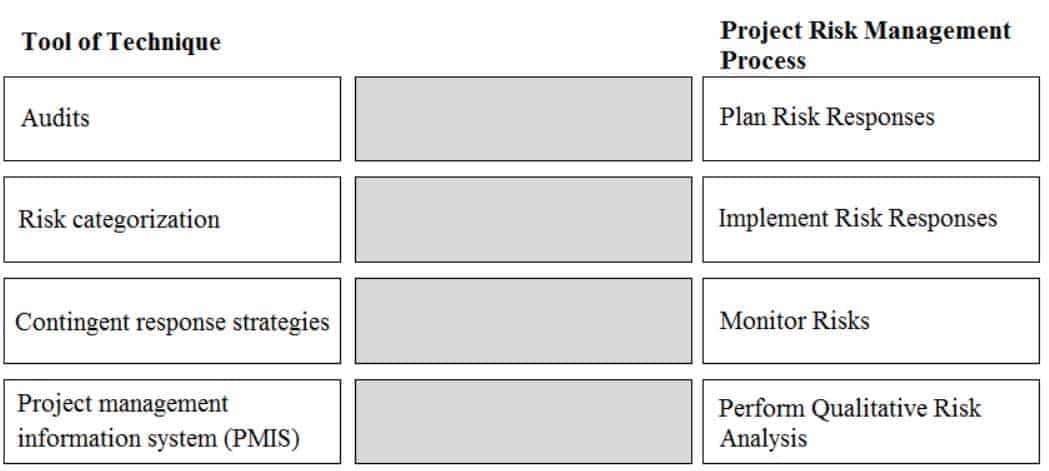CAPM : Certified Associate in Project Management (PMI-100) : Part 54
-
Stakeholder identification and engagement should begin during what phrase of the project?
- After the project management plan is completed
- After the stakeholder engagement plan is completed
- As soon as the project charter has been approved
- After the communications management plan is completed
Explanation:
Reference: https://pmstudycircle.com/2012/06/identify-stakeholders-project-management/
-
In which sphere of influence is the project manager demonstrating the value of project management and advancing the efficacy of the project management office (PMO)?
- The organization
- The project
- The industry
- The product
Explanation:Reference: https://www.greycampus.com/opencampus/project-management-professional/project-manager-role-and-sphere-of-influence -
Which process is engaged when a project team member makes a change to project budget with the project manager’s approval?
- Manage Cost Plan
- Estimate Costs
- Determine Budget
- Control Costs
-
Which of the following is an example of tacit knowledge?
- Risk register
- Project requirements
- Expert judgment
- Make-or-buy analysis
Explanation:Reference: https://www.pmi.org/learning/library/uncovering-tacit-knowledge-projects-7378 -
During which knowledge area stage would a project manager close all contracts appropriately and then close the phase?
- Project Integration Management
- Project Scope Management
- Project Procurement Management
- Project Resource Management
-
What type of risk is Variability risk?
- Emerging risk
- Non-event risk
- Ambiguity risk
- Integrated risk
-
What tool should a project manager use to efficiently manage project resources?
- List of project resources
- Resource breakdown structure
- Resources detailed in the project scope
- Resource requirements
-
Which of the following best correspond to the organizational process assets (OPAs) that affect the project?
- Policies and lessons learned from other projects
- Information technology software and employee capability
- Resource availability and employee capability
- Marketplace conditions and legal restrictions
-
In an adaptive or agile life cycle, how are the customer and sponsor involved in the project scope management activities?
- Involvement is needed only during project initiation
- Minimal involvement of stakeholders is sufficient
- They should be continuously engaged
- They should be involved only during phase or deliverable reviews
-
Make-or-buy analysis is a tool and technique of which process?
- Conduct Procurements
- Plan Procurement Management
- Analyze Procurements
- Control Procurements
Explanation:Reference: https://4squareviews.com/2018/10/02/6th-edition-pmbok-guide-process-12-1-plan-procurement-management-tools-and-techniques-1/ -
Project reporting is a tool that is most closely associated with which process?
- Communicate Plan
- Manage Communications
- Report Performance
- Control Communications
Explanation:Reference: https://www.greycampus.com/opencampus/project-management-professional/communication-methods -
A project manager of a civil construction project is trying to understand the local laws. What example of tailoring procurement could this best be described as?
- Compliance and governance
- Physical location tailoring
- Complexity of procurement
- Availability of contractors
-
A project manager is performing a specific process and has a list of accepted deliverables. One of the stakeholders points out that they have just reviewed the verified deliverables, and come up with the list of accepted deliverables. Which process is being referred to?
- Control Quality
- Validate Scope
- Validate Quality
- Control Scope
Explanation:Reference: https://pmstudycircle.com/2012/10/validated-deliverables-versus-accepted-deliverables/ -
Which component of the project charter defines what the project’s success will look like?
- Project objective
- Project approval requirements
- Project exit criteria
- High-level requirements
-
What does a sender-receiver model accomplish?
- Describes the communications needed to manage the team or physical resources
- Outlines how stakeholders will be engaged through appropriate communication strategies
- Defines the lead, support, and risk management team members for each type of activity
- Creates feedback loops that allow for interaction and participation, and removes barriers
-
What two key components of the project management plan are used as inputs to create the cost management plan?
- Schedule management and risk management plans
- Schedule management and scope management plans
- Procurement management and schedule management plans
- Resource management and schedule management plans
-
What is an input to the stakeholder engagement plan?
- Risk register
- Project charter
- Scope management plan
- Schedule management plan
-
DRAG DROP
Match each tool or technique to its corresponding Project Risk Management process. Click on the tool or technique on the left and drag it to the appropriate gray box in the middle.

CAPM Certified Associate in Project Management (PMI-100) Part 54 Q18 028 Question 
CAPM Certified Associate in Project Management (PMI-100) Part 54 Q18 028 Answer -
What tool or technique uses an algorithm or statistical relationship between historical data and other variables to calculate an activity’s needed resource quantities?
- Expert judgment
- Bottom-up estimating
- Parametric estimating
- Analogous estimating
-
What is the aim of portfolio management?
- Resolving constraints and conflicts that affect multiple projects
- Increasing the likelihood of realizing the desired return on investment (ROI)
- Aligning with the organizational or strategic direction that affects project goals
- Setting up a corporate governance plan for the proper allocation of resources
Subscribe
0 Comments
Newest